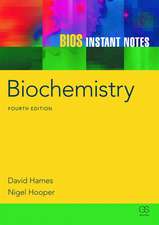Advanced Protocols in Oxidative Stress I: Methods in Molecular Biology, cartea 477
Editat de Donald Armstrongen Limba Engleză Hardback – 9 oct 2008
Cutting-edge and convenient, Advanced Protocols in Oxidative Stress I is an ideal desk reference for scientists wishing to further this research in this exciting, unique and vital field of study.
| Toate formatele și edițiile | Preț | Express |
|---|---|---|
| Paperback (1) | 776.66 lei 38-44 zile | |
| Humana Press Inc. – 20 ian 2011 | 776.66 lei 38-44 zile | |
| Hardback (1) | 600.08 lei 38-44 zile | |
| Humana Press Inc. – 9 oct 2008 | 600.08 lei 38-44 zile |
Din seria Methods in Molecular Biology
- 9%
 Preț: 791.63 lei
Preț: 791.63 lei - 23%
 Preț: 598.58 lei
Preț: 598.58 lei - 20%
 Preț: 882.98 lei
Preț: 882.98 lei -
 Preț: 252.05 lei
Preț: 252.05 lei - 5%
 Preț: 802.70 lei
Preț: 802.70 lei - 5%
 Preț: 729.61 lei
Preț: 729.61 lei - 5%
 Preț: 731.43 lei
Preț: 731.43 lei - 5%
 Preț: 741.30 lei
Preț: 741.30 lei - 5%
 Preț: 747.16 lei
Preț: 747.16 lei - 15%
 Preț: 663.45 lei
Preț: 663.45 lei - 18%
 Preț: 1025.34 lei
Preț: 1025.34 lei - 5%
 Preț: 734.57 lei
Preț: 734.57 lei - 18%
 Preț: 914.20 lei
Preț: 914.20 lei - 15%
 Preț: 664.61 lei
Preț: 664.61 lei - 15%
 Preț: 654.12 lei
Preț: 654.12 lei - 18%
 Preț: 1414.74 lei
Preț: 1414.74 lei - 5%
 Preț: 742.60 lei
Preț: 742.60 lei - 20%
 Preț: 821.65 lei
Preț: 821.65 lei - 18%
 Preț: 972.30 lei
Preț: 972.30 lei - 15%
 Preț: 660.49 lei
Preț: 660.49 lei - 5%
 Preț: 738.41 lei
Preț: 738.41 lei - 18%
 Preț: 984.92 lei
Preț: 984.92 lei - 5%
 Preț: 733.29 lei
Preț: 733.29 lei -
 Preț: 392.60 lei
Preț: 392.60 lei - 5%
 Preț: 746.26 lei
Preț: 746.26 lei - 18%
 Preț: 962.66 lei
Preț: 962.66 lei - 23%
 Preț: 860.22 lei
Preț: 860.22 lei - 15%
 Preț: 652.64 lei
Preț: 652.64 lei - 5%
 Preț: 1055.50 lei
Preț: 1055.50 lei - 23%
 Preț: 883.87 lei
Preț: 883.87 lei - 19%
 Preț: 491.89 lei
Preț: 491.89 lei - 5%
 Preț: 1038.86 lei
Preț: 1038.86 lei - 5%
 Preț: 524.16 lei
Preț: 524.16 lei - 18%
 Preț: 2122.34 lei
Preț: 2122.34 lei - 5%
 Preț: 1299.23 lei
Preț: 1299.23 lei - 5%
 Preț: 1339.12 lei
Preț: 1339.12 lei - 18%
 Preț: 1390.26 lei
Preț: 1390.26 lei - 18%
 Preț: 1395.63 lei
Preț: 1395.63 lei - 18%
 Preț: 1129.65 lei
Preț: 1129.65 lei - 18%
 Preț: 1408.26 lei
Preț: 1408.26 lei - 18%
 Preț: 1124.92 lei
Preț: 1124.92 lei - 18%
 Preț: 966.27 lei
Preț: 966.27 lei - 5%
 Preț: 1299.99 lei
Preț: 1299.99 lei - 5%
 Preț: 1108.51 lei
Preț: 1108.51 lei - 5%
 Preț: 983.76 lei
Preț: 983.76 lei - 5%
 Preț: 728.16 lei
Preț: 728.16 lei - 18%
 Preț: 1118.62 lei
Preț: 1118.62 lei - 18%
 Preț: 955.25 lei
Preț: 955.25 lei - 5%
 Preț: 1035.62 lei
Preț: 1035.62 lei - 18%
 Preț: 1400.35 lei
Preț: 1400.35 lei
Preț: 600.08 lei
Preț vechi: 740.83 lei
-19% Nou
Puncte Express: 900
Preț estimativ în valută:
114.84€ • 119.45$ • 94.81£
114.84€ • 119.45$ • 94.81£
Carte tipărită la comandă
Livrare economică 09-15 aprilie
Preluare comenzi: 021 569.72.76
Specificații
ISBN-13: 9781603272186
ISBN-10: 1603272186
Pagini: 448
Ilustrații: XIV, 430 p. 100 illus., 1 illus. in color.
Dimensiuni: 193 x 260 x 30 mm
Greutate: 1.16 kg
Ediția:2008
Editura: Humana Press Inc.
Colecția Humana
Seria Methods in Molecular Biology
Locul publicării:Totowa, NJ, United States
ISBN-10: 1603272186
Pagini: 448
Ilustrații: XIV, 430 p. 100 illus., 1 illus. in color.
Dimensiuni: 193 x 260 x 30 mm
Greutate: 1.16 kg
Ediția:2008
Editura: Humana Press Inc.
Colecția Humana
Seria Methods in Molecular Biology
Locul publicării:Totowa, NJ, United States
Public țintă
Professional/practitionerCuprins
Reactive Oxygen and Nitrogen Techniques.- Novel Designed Probes for the Characterization of Oxidative Stress in Biological Fluids, Cells, and Tissues.- A Rapid and Selective Mass Spectrometric Method for the Identification of Nitrated Proteins.- An Easy and Reliable Automated Method to Estimate Oxidative Stress in the Clinical Setting.- Correlative Transmission Microscopy: Cytochemical Localization and Immunocytochemical Localization in Studies of Oxidative and Nitrosative Stress.- Detection of Specifically Oxidized Apolipoproteins in Oxidized HDL.- High Performance Liquid Chromatography/Electron Spin Resonance/Mass Spectrometry Analyses of Lipid-Derived Radicals.- EPR Spin-Trapping and Nano LC MS/MS Techniques for DEPMPO/•OOH and Immunospin-Trapping with Anti-DMPO Antibody in Mitochondrial Electron Transfer System.- Determination of High Mitochondrial Membrane Potential in Spermatozoa Loaded with the Mitochondrial Probe 5,5?,6,6?-Tetrachloro-1,1?,3,3?-Tetraethylbenzimidazolyl-Carbocyanine Iodide (JC-1) by Using Fluorescence-Activated Flow Cytometry.- 2,2,6,6-Tetramethylpiperidin-1-Oxyl Probes for Evaluating Oxidative Stress on the Cell Membrane and Mitochondria.- Zymographical Techniques for Detectionof Matrix Metalloproteinases.- The Use of In Vivo Microdialysis Techniques to Detect Extracellular ROS in Resting and Contracting Skeletal Muscle.- Cell-Free Antibody Capture Method for Analysis of Detergent-Resistant Membrane Rafts.- Determination of Acrolein by High-Voltage Capillary Electrophoresis from Oxidized Fatty Acids.- Antioxidant Technology and Application.- Cupric Ion Reducing Antioxidant Capacity Assay for Food Antioxidants: Vitamins, Polyphenolics, and Flavonoids in Food Extracts.- Redox Property of Ribonucleotide ReductaseSmall Subunit M2 andp53R2.- Antioxidant QSAR Modeling as Exemplified on Polyphenols.- Immunohistochemical Staining of Cyclooxygenases with Monoclonal Antibodies.- Examining the Endogenous Antioxidant Response Through Immunofluorescent Analysis of Nrf2 in Tissue.- Determination of Oxidized and Reduced CoQ10 and CoQ9 in Human Plasma/Serum Using HPLC-ECD.- Paraoxonases (PON1, PON2, PON3) Analyses In Vitro and In Vivo in Relation to Cardiovascular Diseases.- Preparation, Characterization, and Use of Antioxidant-Liposomes.- Antioxidant Activity of Biotransformed Sex Hormones Facilitated by Bacillus stearothermophilus.- Biolistic Mediated Production of Transgenic Oil Palm.- Preparation of a Multi-antioxidant Formulation.- Gene Expression.- A Functional Genomics Approach to Identify and Characterize Oxidation Resistance Genes.- Genome-Wide Overexpression Screen for Activators of Antioxidant Gene Transcription.- Method for Conducting Microarray Study of Oxidative Stress Induced Gene Expression.- A Systems Approach Demonstrating Sphingolipid-Dependent Transcription in Stress Responses.- Bioluminescence: Imaging Modality for In Vitro and In Vivo Gene Expression.- Stem Cells.- Reactive Oxygen Species and Upregulation of NADPH Oxidases in Mechanotransduction of Embryonic Stem Cells.- Biostatistics.- Pooling Data When Analyzing Biomarkers Subject to a Limit of Detection.
Textul de pe ultima copertă
Protocols books specializing in measuring free radical and antioxidant biomarkers began to be published in 1998. Many of these methods are currently finding use in diagnostic medicine. Advanced Protocols in Oxidative Stress I covers the field of oxidative stress with state-of-the-art technology to utilize in research, contributed by an international panel of experts renowned for developing new procedures and methods. Included are sections on reactive oxygen and nitrogen species techniques, antioxidant technology and application, methods for analyzing gene expression, the exciting new area of oxidative stress and stem cell differentiation and specific biostatistical evaluation of biomarkers. This volume presents the current high-tech methodologies and provides a perspective on the diversity of applications in the ever-emerging field of free radical reactions and antioxidants. Due to the dynamic nature of this topic, this book will be the first of several volumes of Advanced Protocols in Oxidative Stress, all part of the highly successful Methods in Molecular Biology™ series. As part of the series, the chapters include a brief introduction to the material, lists of the necessary materials and reagents, step-by-step, readily reproducible laboratory protocols, and tips on troubleshooting and ensuring replication of technology.
Cutting-edge and convenient, Advanced Protocols in Oxidative Stress I is an ideal desk reference for scientists wishing to further this research in this exciting, unique and vital field of study.
Cutting-edge and convenient, Advanced Protocols in Oxidative Stress I is an ideal desk reference for scientists wishing to further this research in this exciting, unique and vital field of study.
Caracteristici
Describes novel probes for detecting ROS and RNS Provides theoretical models to predict structural features of polyphenol antioxidants Provides automated assays for ROS metabolites and antioxidant capacity Use of HPLC-nanoHPLC-ESR-MS-ESI-ECD and high-voltage capillary electrophoresis Shows how correlative transmission microscopy allows for in-situ visualization of localized sites of oxidative stress Illustrates immunohistochemistry and bioluminescence techniques Detecting extracellular ROS by microdialysis Describes microarray technology Production of antibodies to detergent-resistant lipid rafts Stress response and gene expression Discusses antioxidant modeling, liposome preparation , response element activity and preparation of multi-antioxidant pharmaceutical formulations Describes HDL-associated paraoxonase enzyme activity in knock-out and transgenic mice








